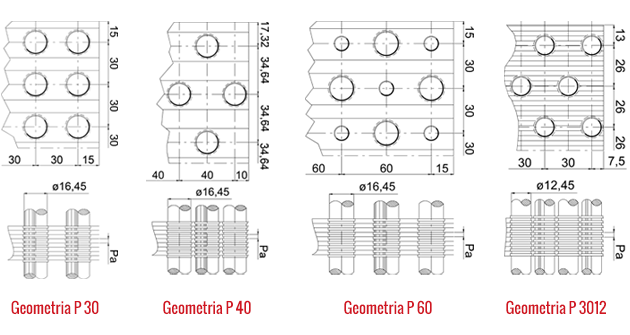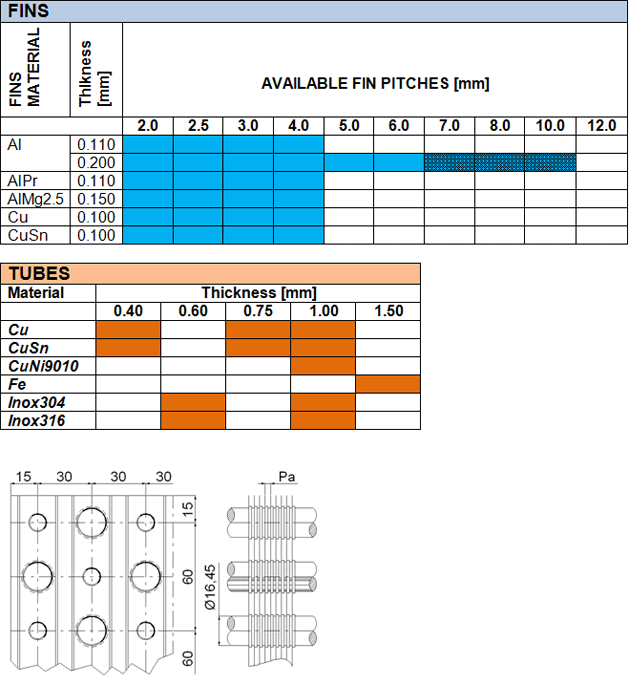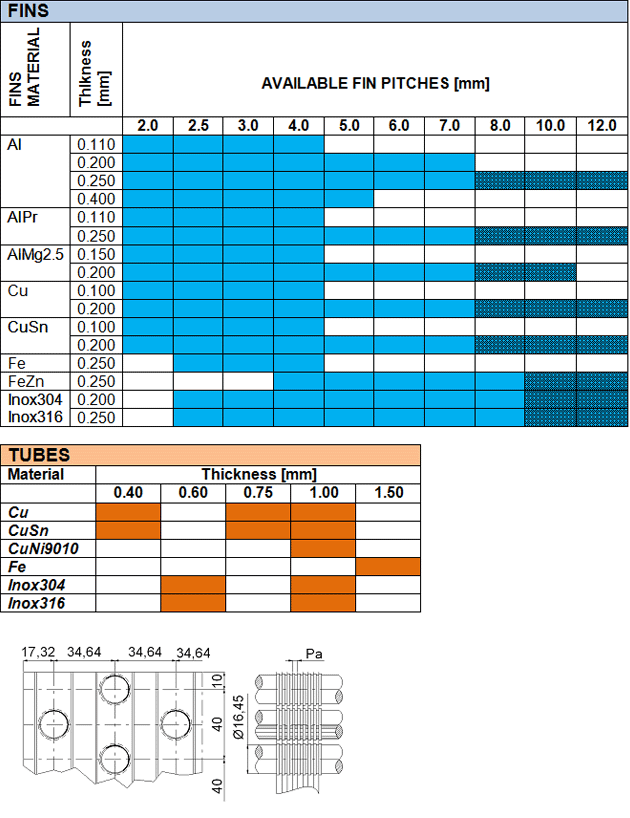DBM coils
DBM S.P.A has over 30 years' experience in the design, manufacture and development of fin/tube heat exchanges.
Exporting 70% of production to various locations which include Australia, United States, the Middle East, North Africa and all European markets.
With state-of-the-art manufacturing facilities and a Research and Development Department that is constantly improving products, machinery and processes enables us to provide increasing demands and requirements of the market.
Our heat exchangers are installed in applications around the world such Gas Turbine Air Intake Cooling Systems, Offshore and Specialized Industrial Processes.
What we offer:
Continuous Fin Type Heat Exchangers available in a wide range of materials, geometries and dimensions (includes water and heating coils, evaporators, refrigerant condensers, diathermic oil heating coils and steam condensers).
Spiral Tubes Coils specifically for industrial use, manufactured in steel, stainless steel and titanium tubes.
Fins are available in a variety of materials and thicknesses
Bare Tube Heat Exchangers for high temperatures (over 300°C) or for applications in which airborne particles like fibres, oil or dust may obstruct the coil face area. Specially manufactured for hospital, clean rooms and pharmaceutical applications.
Heat Pipes for energy recovery systems. Vertical or sloped configuration with optional tilt. Supplied with or without refrigerant.
Cleanable Heat Exchangers manufactured with removable headers to facilitate the internal cleaning of tubes. These are supplied with either finned block or spiral tubes.
Energy Recovery Wheels for air-to-air recovery in ventilation systems and air handling units. Rotor in
aluminium or hygroscopic aluminium for latent heat recovery. Available with constant or variable speed drive systems.
Run Around Heat Exchangers for Heat/Energy recovery systems with finned block coils, spiral and bare tubes.
Accessories:
We offer a wide range of accessories, including:
- Plastic or stainless-steel moisture eliminators (integrated, removable or slide out).
- Flat or sloped, fixed or removable drain trays.
- Fixed or removable protection guards.
- Flanges.
- Defrosting systems through electric resistors, hot water or hot gas injection.
- Anti-corrosive treatments and coatings such as Heresite P413, Blygold, Cataphoresis and Electro-tinning.
- Spray or powder painting for the casing or the coil block.
- Special or customised frame executions.
Geometries:
DBM spa has four different geometries available.


Materials:
Available materials for tubes, fins and possible fins pitches.
P60
P40
P3012
Coatings:
Blygold Technologies have provided for the last 35 years the HVAC/R industry a set of solutions to increase the life of systems as well as maintain their energy efficiency for the last 35 years.
The wide range of Blygold products and services responds to all HVAC/R needs, including:
- HVAC/R systems efficiency and reliability.
- Resistance to aggressive acids, environments and climates.
- Resistance to temperature.
- Quality of air
The Blygold Standard painting system for copper-aluminium coils, which withstands 4000-hour salt-spray tests, is the following:
− Cleaning of surfaces to be coated with hot water at 100 bar and “Coil Clean” cleaning agent
− Rinsing with sweet water to remove cleaning agent
− Removal of residues of water with compressed air
− Combing of fins to improve material penetration (if required)
− Painting system on aluminium fins: supply and application of PoluAl XT to a dry film thickness of 25-30 Hm applied with special equipment
− Painting system on casing and external copper tubes:
Supply and application of one coat of Refamac 3509 Primer to a dry film thickness of 55-60 Hm
Supply and application of one coat of PoluAl XT MB to a dry film thickness of 25-30 Hm
Inspection and quality control in accordance to Blygold protocol.
Blygold Standard Painting System for Copper-Copper Coils
The Blygold Standard painting system for copper-copper coils, which withstands 4000-hour salt-spray tests, is the following:
− Cleaning of surfaces to be coated with hot water at 100 bar and “Coil Clean” cleaning agent
− Rinsing with sweet water to remove cleaning agent
− Removal of residues of water with compressed air
− Combing of fins to improve material penetration (if required)
− Painting system on aluminium fins:
Supply and application of a first coat of PoluAl XT
Supply and application of a second coat of PoluAl XT to a total dry film thickness of 25-30 Hm applied with special equipment
− Painting system on casing and external copper tubes:
Supply and application of one coat of Refamac 3509 Primer to a dry film thickness of 55-60 Hm
Supply and application of one coat of PoluAl XT MB to a dry film thickness of 25-30 Hm
Inspection and quality control in accordance to Blygold protocol.
The Blygold PoluAl XT coating provides a long-lasting corrosion protection to heat exchangers, without affecting heat transfer and pressure drop.
Treatment: Blygold PoluAl XT
Coating type: Aluminium pigmented polyurethane
Colour: Champagne
Pre-treatment: Degreasing
Temperature Range (dry): -20 to 150°C (-4° to 302°F)
Substrates: Aluminium and Copper
ASTM B117: 4000+ hours (neutral-salt spray test)
ASTM B-287: 4000+ hours (acid-salt spray test)
Kesternich (2.0 ltr SO2): 80 cycles
Layer Thickness: 25-30 μm (1 mil)
Pressure Drop: 0-5 % (depending on fin geometry)
Thermal Resistance: 0-3 % (depending on fin geometry)
Application: Qualified Blygold Applicator
UV Resistance: Excellent
Adhesion (cross hatch): 0 (European) 5b (USA)
Applications: Heat exchanging surfaces in corrosive conditions
Chemical Resistance: Excellent
Heresite
Heresite P-413C is a thermosetting phenolic coating with high corrosion resistance and chemical inertia.
System description:
- Cleaning of surfaces to be coated with hot water and cleaning agent.
- Rinsing with sweet water to remove cleaning agent.
- Removal of residues of water with compressed air.
- Fins alignment to facilitate product application (if necessary);
- Supply and application of Heresite P-700 to a dry film thickness of 5-10 μm;
- Pre-polymerization in oven at 150°c;
- Supply and application of Heresite P-413C to a dry film thickness of 10-15 μm;
- Pre-polymerization in oven at 110°c;
- Supply and application of Heresite P-413C to a dry film thickness of 10-15 μm;
- Pre-polymerization in oven at 110°c;
- Supply and application of Heresite P-413C to a dry film thickness of 10-15 μm;
- Pre-polymerization in oven at 110°c;
- Inspection prior to final polymerization.
- Final polymerization in oven at 204°C.
Cataphoresis
Description: Electrodeposition painting
Application: Indicated as primed
Features: Excellent resistance to corrosion
Technical Data:
Black Colour
– Thickness 15 – 35 μm
– Pencil hardness 2H – 3H
– Gloss 60°: 50 ± 5
– Erichsen > 4 mm
– Salt Spray according to ASTM B 117-90 – 700 hours, maximum 1 – 2 mm creep (zinc phosphate)
– Humidity Resistance according to ASTM D 2247-68 – 2000 hours unchanged (zinc phosphate)
– Resistance against according to DIN EN ISO 2812-4
Hydraulic oil
Motor oil
Gasoline
Liquid brake
Coolant
Diesel
Warnings
– This type of coating has poor resistance to UV exposure, so it is not suitable for exposure to direct sunlight.
– Resistance to Salt Spray is heavily influenced by:
Type of material.
Shape of the article (e.g. presence of sharp edges).
Performed at or above cataphoresis treatment (zinc coating, heat treatment, etc.).
Surface conditions (oil, welding, oxidation, chemical residues or other contaminants).
– The material that presents forms boxed (tubular frames or complex structures) must have the drain holes being the cataphoresis an immersion process.
– The cataphoresis is not a galvanic process which the galvanizing but is a process of painting.
Cycle
1. Alkaline degreasing spray
2. Rinse immersion:
3. Rinse immersion.
4. Activation immersion (room temperature).
5. Immersion phosphating with zinc salts microcrystalline
6. Rinse immersion.
7. Rinse immersion.
8. Rinsing with demineralized water immersion.
9. Cathodic electrodeposition immersion (cataphoresis).
10. Rinse 1 immersion with ultrafiltrate.
11. Rinse 2 to dive with ultrafiltrate.
12. Polymerization in an oven at ~ 180°C on the work piece
Tin Plating
The process of tin plating brings back a semi polished silver-white to the treated material, an excellent weldability and a good resistance to corrosion, above all on products which are in direct contact with liquids. Being a non-toxic barrier, it is also recommended for the food industry. A nickel layer on the base metal forestalls the natural darkening of the tin (multi-layered nickel-tin process).
The maximum finned length for a completely tinned coil is approximately 5500mm.